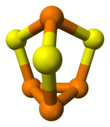Phosphorus sesquisulfide is the inorganic compound with the formula P4S3. It was developed by Henri Sevene and Emile David Cahen in 1898 as part of their invention of friction matches that did not pose the health hazards of white phosphorus.[2][3] This yellow solid is one of two commercially produced phosphorus sulfides. It is a component of "strike anywhere" matches.
| |||
 | |||
| Names | |||
|---|---|---|---|
| IUPAC names
Tetraphosphorus trisulfide or 3,5,7-trithia-1,2,4,6-tetraphosphatricyclo[2.2.1.02,6]heptane | |||
| Other names
phosphorus trisulfide, phosphorus sesquisulfide, phosphorus sulfide | |||
| Identifiers | |||
3D model (JSmol) |
|||
| ChemSpider | |||
| ECHA InfoCard | 100.013.860 | ||
PubChem CID |
|||
| RTECS number |
| ||
| UNII | |||
CompTox Dashboard (EPA) |
|||
| |||
| |||
| Properties | |||
| P4S3 | |||
| Molar mass | 220.093 g/mol | ||
| Appearance | Yellow, yellow-green or gray solid | ||
| Density | 2.08 g.cm3,[1] solid | ||
| Melting point | 172.5 °C (342.5 °F; 445.6 K) | ||
| Boiling point | 408 °C (766 °F; 681 K) | ||
| Structure | |||
| orthorhombic, Schönflies notation D2h | |||
| Pmnb | |||
| C3v | |||
| Related compounds | |||
Related compounds |
P4S10 P4O6 | ||
| Hazards | |||
| Occupational safety and health (OHS/OSH): | |||
Main hazards |
Irritant | ||
| GHS labelling: | |||
 | |||
Except where otherwise noted, data are given for materials in their standard state (at 25 °C [77 °F], 100 kPa).
| |||
Depending on purity, samples can appear yellow-green to grey. The compound was discovered by G. Lemoine and first produced safely in commercial quantities in 1898 by Albright and Wilson. It dissolves in an equal weight of carbon disulfide (CS2), and in a 1:50 weight ratio of benzene. Unlike some other phosphorus sulfides, P4S3 is slow to hydrolyze and has a well-defined melting point.
Structure and synthesis
The molecule has C3v symmetry. It is a derivative of the tetrahedral (P4) unit from insertion of sulfur into three P-P bonds. The P-S and P-P distances are 2.090 and 2.235 Å, respectively. P4Se3 and P4S3 adopt the same structures.[1] These compounds can be melted together and form mixed crystals of one dissolved in the other.[4] Under higher temperatures, mixed chalcogenide molecules P4S2Se and P4SSe2 will form.[5]
P4S3 is produced by the reaction of red or white phosphorus with sulfur. Excess sulfur gives phosphorus pentasulfide (P4S10). It is estimated that 150 ton/y were produced in 1989.[6]
Applications
P4S3 and potassium chlorate, together with other materials, composes the heads of "strike-anywhere matches".[7]
Safety
Its flash point is about 100 °C.[8]
Health effects
Exposure to "strike anywhere" matches containing phosphorus sesquisulfide can cause contact dermatitis, usually in the pocket area but also on the face.[9] Exposure over a long period of time to burning match tips (containing phosphorus sesquisulfide) can result in a recurring severe primary dermatitis about the eyes and face. Loosening of the teeth has also been reported which may have been due to phosphorus poisoning.[10]
References
Wikiwand in your browser!
Seamless Wikipedia browsing. On steroids.
Every time you click a link to Wikipedia, Wiktionary or Wikiquote in your browser's search results, it will show the modern Wikiwand interface.
Wikiwand extension is a five stars, simple, with minimum permission required to keep your browsing private, safe and transparent.


